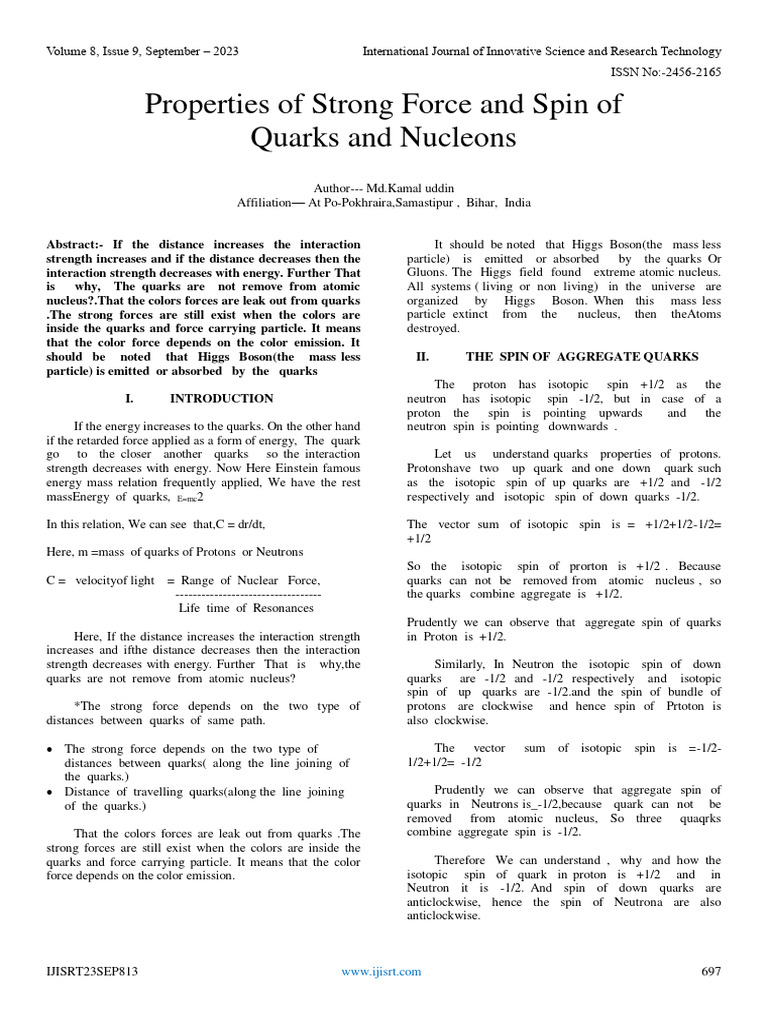The strong force, often referred to as the strong nuclear force or strong interaction, is one of the four fundamental forces of nature, alongside gravity, electromagnetism, and the weak nuclear force. It is the dominant force that binds quarks together, ensuring the stability of protons and neutrons, which in turn constitute atomic nuclei. This article delves into the intricacies of the strong force, exploring its characteristics, mediator particles, implications for particle physics, and its profound role within the realm of quantum chromodynamics (QCD).
1. Fundamental Characteristics of the Strong Force
The strong force is characterized by its exceptionally high strength, which operates at short ranges, typically less than one femtometer (10-15 meters). Unlike the gravitational force, which diminishes with distance and remains active across cosmic scales, the strong force is confined to the atomic nucleus, making it crucial for nuclear stability. This force is fundamental to understanding why atomic nuclei can exist in the face of the electromagnetic repulsion between positively charged protons.
One of the most distinctive features of the strong force is its unique property of asymptotic freedom, which refers to the phenomenon where quarks become increasingly free as they approach each other. This counterintuitive behavior contrasts sharply with other fundamental forces, such as electromagnetism, which grows stronger with proximity.
2. Mediators of the Strong Force: Gluons and Color Charge
In the context of particle physics, the strong force is mediated by particles known as gluons. Gluons are massless gauge bosons that facilitate the interaction between quarks, the fundamental constituents of protons and neutrons. Each quark bears a property known as “color charge,” which is analogous to electric charge but operates under a threefold symmetry (red, green, and blue). Gluons convey the strong force by exchanging color charges among quarks, leading to a phenomenon termed “color confinement”—a principle stating that quarks cannot exist in isolation and must form color-neutral combinations.
For instance, a proton comprises three quarks (two up quarks and one down quark), which combine their color charges to create a neutral state, while a neutron consists of two down quarks and one up quark. The interaction via gluons ensures that these quarks remain bound together, despite the significant electromagnetic forces that might otherwise prevail.
3. Quantum Chromodynamics: The Underpinning Theory
The theoretical framework describing the strong force is encapsulated within Quantum Chromodynamics (QCD). QCD is a quantum field theory that elucidates the dynamics of quarks and gluons, emphasizing the significance of their interactions. This complex theory emerges from the principles of gauge invariance and symmetry, underlying the interactions among various types of elementary particles.
According to QCD, the interactions between quarks and gluons can be mathematically represented using Feynman diagrams. These diagrams illustrate the exchange of gluons among quarks and depict how color charge conservation plays a critical role in particle interactions. However, the non-abelian nature of the SU(3) gauge group governing QCD results in self-interactions among gluons, complicating the theoretical landscape and necessitating advanced mathematical treatments.
4. Implications for Particle Physics and Cosmology
The implications of the strong force extend beyond the confines of atomic nuclei. It plays a pivotal role in our understanding of particle physics, particularly in high-energy collisions observed in particle accelerators like the Large Hadron Collider (LHC). Experiments probing the characteristics of the strong force help to uncover the underlying structure of matter and refine our knowledge of the early universe during the plasma epoch, shortly after the Big Bang.
During this critical timeframe, it is posited that quarks and gluons existed in a free state known as quark-gluon plasma, which demonstrates the extreme conditions under which the strong force operates. An understanding of this phase transition is crucial for comprehending the universe’s evolution and the formation of baryonic matter.
5. Strong Force in Astrophysics
In addition to its role in particle physics, the strong force is instrumental in astrophysical contexts. Neutron stars represent an extraordinary example, where the gravitational collapse of massive stars post supernova leads to a state predominantly composed of neutrons. Here, the interplay of the strong force becomes paramount, as it counteracts gravitational collapse, leading neutron stars to exhibit astonishing densities, with a teaspoon of neutron-star material weighing approximately the same as an elephant.
Moreover, the stability of atomic nuclei is rooted in the delicate balance of strong and weak forces. This balance dictates the processes of nucleosynthesis occurring in stars, where heavier elements are forged under extreme pressure and temperature, resulting in the diversity of matter we observe in the universe today.
Conclusion
In summation, the strong force between quarks is an essential component of the fundamental framework of physics, governing the stability of matter at the most elementary levels. Understanding this force not only sheds light on the structure of atomic nuclei but also enhances our comprehension of the universe’s origins and the complex phenomena that govern stellar life cycles. The interplay of quarks and gluons, encapsulated in the robust theory of Quantum Chromodynamics, remains a vibrant field of study, offering endless curiosity and challenges for physicists and cosmologists alike.












